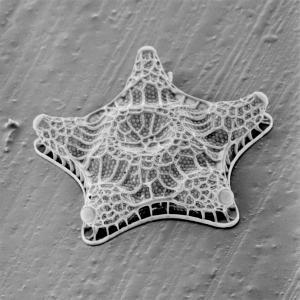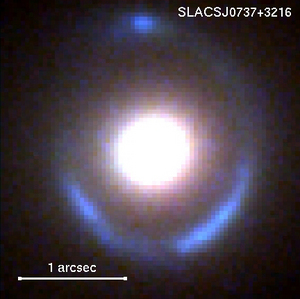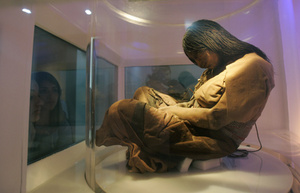A plant-like micro-organism mostly found in oceans could make the manufacture of products, from iridescent cosmetics, paints and fabrics to credit card holograms, cheaper and 'greener.'
The tiny single-celled 'diatom', which first evolved hundreds of millions of years ago, has a hard silica shell which is iridescent -- in other words, the shell displays vivid colours that change depending on the angle at which it is observed. This effect is caused by a complex network of tiny holes in the shell which interfere with light waves.

|
| ©Engineering and Physical Sciences Research Council
|
| A small organism with big potential: a diatom magnified by scanning electron microscope.
|
A tiny galaxy, nearly halfway across the universe, the smallest in size and mass known to exist at that distance, has been identified by an international team of scientists led by two from the University of California, Santa Barbara.

|
| ©Marshall & Treu (UCSB)
|
| Color composite image of the gravitational lens system, made from Hubble (blue and green) and Keck (red) data. The blue ring is the tiny background galaxy, stretched by the gravitational pull of the foreground lens galaxy at the center of the image.
|
The scientists used data collected by NASA's Hubble Space Telescope and the W. M. Keck Observatory in Hawaii. This galaxy is about half the size, and approximately one-tenth the "weight" of the smallest distant galaxies typically observed, and it is 100 times lighter than our own Milky Way.
Could the exploitation of space solve the earth's environmental crises?
The Soviet Union successfully launched Sputnik I fifty years ago on October 4th, marking the beginning of our use of space for political, military, technological, and scientific ends. Since then we have launched hundreds of satellites, space probes, telescopes, moon missions, and planetary landers. Now, political scientist Rasmus Karlsson suggests that space could provide us with a sustainable future not possible from an earthbound only perspective.
Writing in the October issue of Inderscience publication, International Journal of the Environment and Sustainable Development, Karlsson, a researcher at the University of Lund, Sweden, explains that over the years, two strands of thought on sustainable development have emerged. They are ecologism and environmentalism. Ecologism offers a solution by emphasizing the need for major socioeconomic reform aimed at a post-industrial era. Environmentalism, in contrast, focuses on the preservation, restoration, and improvement of the natural environment within the present framework.
It can take your pulse, check your body fat, time your jogs and tell you if you have bad breath. It even assesses stress levels and inspires you with a pep talk. Meet your new personal trainer: your cell phone.
The prototype Wellness mobile phone from Japan's NTT DoCoMo Inc. (DCM) targets users with busy lives who want a hassle-free way of keeping track of their health, according to company spokesman Noriaki Tobita.
Craig Venter, the controversial DNA researcher involved in the race to decipher the human genetic code, has built a synthetic chromosome out of laboratory chemicals and is poised to announce the creation of the first new artificial life form on Earth.
The announcement, which is expected within weeks and could come as early as Monday at the annual meeting of his scientific institute in San Diego, California, will herald a giant leap forward in the development of designer genomes. It is certain to provoke heated debate about the ethics of creating new species and could unlock the door to new energy sources and techniques to combat global warming.
Children selected for Inca ritual sacrifice were "fattened up" with high-protein diets in the months leading up to their deaths, a new study has found.
Researcher Andrew Wilson and his team conducted DNA and chemical tests of hair samples taken from four child mummies found in the Andes mountains in the 1990s. (See a
photo gallery of the frozen Inca mummies.)

|
| ©National Geographic
|
For more than 40 years, an asteroid believed to be potentially dangerous to Earth has been essentially lost to view. But no more.
The so-called 6344 P-L was first spotted in 1960, and given the designation Potentially Hazardous Asteroid - meaning that its orbit took it within .05 astronomical units (about 4,650,000 miles) of Earth's orbit. But astronomers lost track of it; left behind was only a number and a vague sense of threat.
However, meteor researcher Peter Jenniskens of the SETI institute now argues, with confirmation from the Smithsonian Astrophysical Observatory' Minor Planet Center, that this wayward wanderer is in fact the same thing as the recently discovered 2007 RR9, making a reappearance this year as part of a 4.7-year orbit.
With atoms and molecules in a gas moving at thousands of kilometres per hour, physicists have long sought a way to slow them down to a few kilometres per hour to trap them.

|
| ©Image courtesy of Institute of Physics
|
| The coils used to slow the atoms.
|
Researchers achieved the unlikely feat by vigorously vibrating the droplets. The force created when they bulged upwards as the surface they were on dropped was enough to make them trickle up a steep slope.
Watch a vibrating droplet flow uphill
HERE







